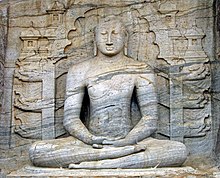
Back سامادهي Arabic Самадхи Bulgarian সমাধি (ভারতীয় দর্শন) Bengali/Bangla Samádhi Czech Samadhi Danish Samadhi German Samadhi Spanish Samādhi Estonian سامادی Persian Samadhi Finnish


Samādhi (Pali and Sanskrit: समाधि), in Hinduism, Buddhism, Jainism, Sikhism and yogic schools, is a state of meditative consciousness. In many Indian religious traditions, the cultivation of Samādhi through various meditation methods is essential for the attainment of spiritual liberation (known variously as nirvana, moksha).[1]
In Buddhism, it is the last of the eight elements of the Noble Eightfold Path.[web 1] In the Ashtanga Yoga tradition, it is the eighth and final limb identified in the Yoga Sutras of Patanjali.[2][3] In Jain meditation, samadhi is considered one of the last stages of the practice just prior to liberation.[4]
In the oldest Buddhist sutras, on which several contemporary western Theravada teachers rely, it refers to the development of an investigative and luminous mind which is equanimous and mindful. In the yogic traditions, and the Buddhist commentarial tradition on which the Burmese Vipassana movement and the Thai Forest tradition rely, it is interpreted as a meditative absorption or trance, attained by the practice of dhyāna.[5]
- ^ Pragya, Samani Pratibha (2017), Prekṣā meditation : history and methods, p. 82. PhD Thesis, SOAS, University of London
- ^ "The eight limbs, The core of Yoga". Expressions of Spirit.
- ^ "8 Limbs of Yoga: Samādhi". Families.
- ^ Pragya, Samani Pratibha (2017), Prekṣā meditation : history and methods, p. 82. PhD Thesis, SOAS, University of London
- ^ Sarbacker 2012, p. 13.
Cite error: There are <ref group=web> tags on this page, but the references will not show without a {{reflist|group=web}} template (see the help page).
© MMXXIII Rich X Search. We shall prevail. All rights reserved. Rich X Search